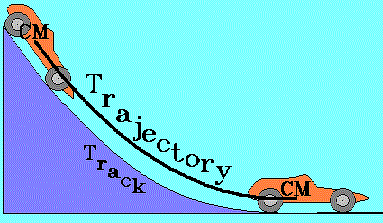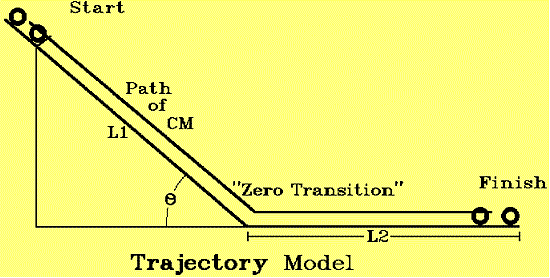| Grand Prix Racing - |
The Science of Fast Pinewood Cars |
Car Trajectory
To model the path of a Grand Prix car on a track, it is not really the
location of the surface of the track we are interested in. We really want
the path of the center of mass (CM) of your car to be modeled.
This center of mass is in a sense the "heart" that brings your wooden
creation to life. Once this path is known, the acceleration, speed and time
of the racing car can be found from the model expressions derived for the
ramp and flat. Expressions for the height of the trajectory above the track
and the lengths of parts of the trajectory are derived.
Physically, the center of mass is where your car balances on a pencil.
Half its weight is on either side of the pencil. The center of mass is a
key to the behavior of each car in a race. Your car rotates about this
point when not touching anything else. It is as if the force of gravity
acts only on this one point inside your car. Of course that's not true, but
we can use this fortuneate behavior to greatly simplify our models.
To properly model the behavior of your car on a track, we must know
where your car's center of mass is at all points along the track. This path
traveled by the center of mass is called the car's trajectory. In
particular, the length of the trajectory paths on the ramp and flat are
used with the closed models to determine race speed, time and other
dynamics.
In principle, the location of your car's trajectory is just the height
of your car's center of gravity above the track surface. This simplicity is
hidden somewhat in the way that your car's simple
geometry is rotated to the track's ramp angle through trigonometric
functions. Finding this extra height on the ramp and flat is straight
forward. The extra height and rotation of the car on the ramp changes the
distance traveled on the ramp and flat.
To model your car's trajectory on an official AWANA track, we break it
up into ramp and flat parts like the track. In the
AWANA track model developed in this manual, the transition section was
reduced to zero length for convenience. In general it does have a greater
length. But even in the zero length case, the transition produces a
different trajectory arc from the ramp or flat. But it can safely be
ignored in the zero length transition case.
| The Ramp |
L1 = Distance from CM at starting line to the normal to the contact
point on the ramp at the join. |
| The Flat |
L2 = Distance from the end of L1 to CM where the nose crosses the
finish line. |
We will find an expression for the length of a car's trajectory by
considering the flat first, then the ramp. This progression allows us to
find the easy length first, then the harder ones.
The Flat
From the time the rear wheels first touch the flat part of the track,
your car will travel in a straight line until its nose is over the finish
line. Since there is no rotation about its center of mass, the trajectory
will be a straight line also. When the front and rear wheel radii are the
same, Rf = Rr, the center of mass (CM) is Rr + CMy above the track. CMy is
the distance your car's CM is above its rear axle. When the front and rear
wheels have different radii, the base of the car is tipped at an angle, *,
where * = arctan((Rf-Rr)/B) and B, the wheel base, is the distance between
the front and rear axles. Note * is negative when the rear wheels are
taller than the front wheels because the car slopes down.
This bit of tilt rotates the center of mass so it is now CMycos* +
CMxsin* above the rear axle instead of just CMy. CMx is the distance from
the rear axle to the center of mass (a positive number when the center of
mass is in front of the axle). So the height of the center of mass above
the track is
Rr + CMycos* + CMxsin*, where * = arctan((Rf-Rr)/B).
Where are the ends of the flat part of the track? In this simplified
trajectory, the join end is more difficult. Let's do the finish line end
first. When your car noses up to the finish line, it's center of mass is
behind the line. The distance behind the finish line is the length of the
nose plus the wheel base minus the distance to the center of mass from the
rear axle. Written in symbols it is,
Finish: N + B - CMx and when * is not zero, (N + B - CMx)cos* +
CMysin*
On the initial end of the flat, the intersection of the ramp trajectory
and flat trajectory lies along the ramp, flat bisection angle. This is
because the trajectory on both the ramp and flat is elevated by the same
amount, Rr + CMycos* + CMxsin* or just Rr + CMy when * is zero (Rr = Rf).
Projecting the intersection point down to the flat, means that we have a
right triangle with the normal to the intersection forming the right angle
to the flat (by definition). Call the distance from the normal to the join
"x". Call the length of the normal "y". Then y is distance the trajectory
is elevated above the flat.
y = Rr + CMycos* + CMxsin* or just Rr + CMy when * is zero (Rr = Rf)
Since the compliment of the ramp angle, O, is pi + O, since O is
negative, its bisector is (pi+O)/2. The tangent expression can now be
written as:
y/x = -tan((pi+O)/2)
But this can be rexpressed using the identity,
tan(pi/2-(-A)) = 1/tan(-A) for positive A so,
y/x = -1/tan(O/2)
Solving for x gives
x = -ytan(O/2) which is
x = -(Rr + CMycos* + CMxsin*)tan(O/2) after expanding y.
Join: -(Rr + CMy)tan(O/2) and when * is not zero, -(Rr + CMycos* +
CMxsin*)tan(O/2)
The length of the flat is Lf. To get your car's trajectory length on
this part of the trajectory, L2, we simply subtract the distance from the
center of mass to the finish and the distance from the join to the
trajectory intersection normal on the flat,
L2 = Lf - N - B + CMx + (Rr + CMy)tan(O/2)
or if * is not zero,
L2 = Lf - (N + B - CMx)cos* - CMysin* + (Rr + CMycos* +
CMxsin*)tan(O/2)
On the ramp, the car is already tipped downward by the ramp angle, O.
The center of mass, the point directly below it on the track and the point
on the track whose normal passes through the center of mass form a right
triangle. By definition, the normal line is at right angles to the track
surface, so the vertex at the center of mass has an angle of theta. If the
front and rear wheels have the same radii, Rf and Rr, the height to the
center of mass from the tipped track is (Rr+CMy)/cosO. When Rf and Rr are
not equal, the center of mass is rotated about the axle so the height
becomes (Rr + CMycos* + CMxsin*)/cosO. This height does not change while
the car is on the ramp.
At the starting line, the center of mass is behind it. To determine how
far behind the starting line the center of mass is, we can ignore the ramp
tilt. The center of mass is behind the line by the length of its nose plus
its wheel base minus its distance from the rear axle. This is,
Start: N + B - CMx and when * is not zero, (N+B-CMx)cos* + CMysin*
At the join end, the same considerations apply as on the flat. Only this
time, the normal, y, is projected on to the ramp. The logic and results are
the same.
Join: -(Rr + CMy)tan(O/2) and when * is not zero, -(Rr + CMycos* +
CMxsin*)tan(O/2)
The length of the ramp is Lr. To get your car's trajectory length on
this first part of the trajectory, L1, we simply add the distance from the
center of mass to the starting line and subtract the distance from the join
to the trajectory intersection normal on the ramp,
L1 = Lr + N + B - CMx + (Rr + CMy)tan(O/2)
or if * is not zero,
L1 = Lr + (N+B-CMx)cos* + CMysin* + (Rr + CMycos* + CMxsin*)tan(O/2)
In summary, the trajectory geometry equations are as follows.
| EXPRESSION |
UNITS |
DESCRIPTION |
| * = arctan((Rf-Rr)/B) |
degrees |
Tilt of car due to different size front and rear wheels |
| h(y) = (Rr + CMycos* + CMxsin*)/cosO + H - ysinO |
inches |
Height of trajectory on ramp |
| L1 = Lr + (N+B-CMx)cos* + CMysin* + (Rr + CMycos* +
CMxsin*)tan(O/2) |
inches |
Length of car's trajectory on ramp |
| 0 <= y <= L1 |
inches |
Range of arc parameter along ramp |
| h(y) = Rr + CMycos* + CMxsin* |
inches |
Height of trajectory on flat |
| L2 = Lf - (N + B - CMx)cos* - CMysin* + (Rr + CMycos* +
CMxsin*)tan(O/2) |
inches |
Length of car's trajectory on flat |
| 0 <= y <= L2 |
inches |
Range of arc parameter along flat |
| Grand Prix Racing - |
The Science of Fast Pinewood Cars |
| Copyright © 1997, 2004 by Michael Lastufka, All rights reserved worldwide. |

